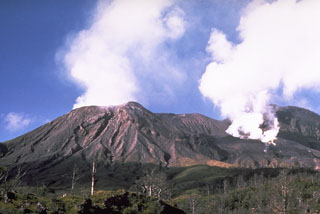Report on Langila (Papua New Guinea) — March 1995
Bulletin of the Global Volcanism Network, vol. 20, no. 3 (March 1995)
Managing Editor: Richard Wunderman.
Langila (Papua New Guinea) Moderate emissions and explosions from Crater 2
Please cite this report as:
Global Volcanism Program, 1995. Report on Langila (Papua New Guinea) (Wunderman, R., ed.). Bulletin of the Global Volcanism Network, 20:3. Smithsonian Institution. https://doi.org/10.5479/si.GVP.BGVN199503-252010
Langila
Papua New Guinea
5.525°S, 148.42°E; summit elev. 1330 m
All times are local (unless otherwise noted)
"Monitoring was temporarily discontinued on 18 March. Until that time activity at Crater 2 was at a moderate level, similar to that observed in February, while Crater 3 showed a low level of activity. Emissions from Crater 2 were mostly white vapour, weak to moderate in volume. Occasionally grey ash clouds were emitted. Light ash fall took place around the crater. One loud explosion was heard on 8 March with weak explosions on the following two days and low rumbling sounds on the 16th. Steady weak night glow was observed on 16 and 17 March. Crater 3 released very thin to occasionally moderately thick white vapour. Thin blue vapour was observed on 1 and 7 March. There were no audible sounds and no night glows. Both seismographs remained inoperative throughout the month."
Geological Summary. Langila, one of the most active volcanoes of New Britain, consists of a group of four small overlapping composite basaltic-andesitic cones on the lower E flank of the extinct Talawe volcano in the Cape Gloucester area of NW New Britain. A rectangular, 2.5-km-long crater is breached widely to the SE; Langila was constructed NE of the breached crater of Talawe. An extensive lava field reaches the coast on the N and NE sides of Langila. Frequent mild-to-moderate explosive eruptions, sometimes accompanied by lava flows, have been recorded since the 19th century from three active craters at the summit. The youngest and smallest crater (no. 3 crater) was formed in 1960 and has a diameter of 150 m.
Information Contacts: B. Talai, RVO.

